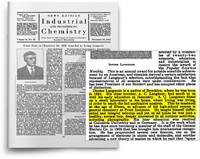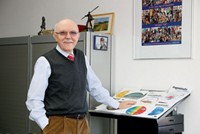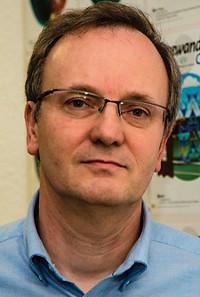Advertisement
Grab your lab coat. Let's get started
Welcome!
Welcome!
Create an account below to get 6 C&EN articles per month, receive newsletters and more - all free.
It seems this is your first time logging in online. Please enter the following information to continue.
As an ACS member you automatically get access to this site. All we need is few more details to create your reading experience.
Not you? Sign in with a different account.
Not you? Sign in with a different account.
ERROR 1
ERROR 1
ERROR 2
ERROR 2
ERROR 2
ERROR 2
ERROR 2
Password and Confirm password must match.
If you have an ACS member number, please enter it here so we can link this account to your membership. (optional)
ERROR 2
ACS values your privacy. By submitting your information, you are gaining access to C&EN and subscribing to our weekly newsletter. We use the information you provide to make your reading experience better, and we will never sell your data to third party members.
People
Angewandte Chemie Celebrates Its 125th Anniversary
Chemists from around the world gather to fete the German Chemical Society’s premier publication
by Sarah Everts
March 21, 2013
| A version of this story appeared in
Volume 91, Issue 12

Close to 1,500 chemists convened in Berlin on March 12 to celebrate the 125th anniversary of the German Chemical Society’s journal Angewandte Chemie. Now published by John Wiley & Sons, it began in 1887 as a technical magazine for German industrial chemists. Today it is one of the most respected journals for molecular and material scientists.
The daylong birthday fest featured music from a saxophone quartet as well as talks and accolades by more than a dozen renowned chemists. “Today we celebrate a great event,” said Ahmed H. Zewail, a chemist at California Institute of Technology who won the Nobel Prize in Chemistry in 1999.
So Punny!
From tributes to 1980s pop band the Bangles (Just another Mannich Monday) to risqué references (Metal ménage à trois), much has been said of the funny kickers that grace the abstracts of papers in Angewandte Chemie.
The brains behind the humor range from giddy journal editors to zealous authors. A recent submission on photochemistry paid tribute to Pink Floyd’s “Shine on You Crazy Diamond,” according to Editor-in-Chief Peter Gölitz.
When news of the journal’s anniversary party broke on Twitter, Matthew Hartings, a chemist at American University who tweets as @sciencegeist, asked about “a chemical pun-writing contest.” His question launched a short Twitter pun competition about the party. Contributions included “125 year self-assembly process” and “Activation barrier for self-assembly reduced by cake.”
George M. Whitesides, a Harvard University chemist, added praise for the journal’s longtime editor, Peter Gölitz. “A great journal is the reflection of a great editor,” he said. Whitesides commended Gölitz’ flexible definition of what constitutes chemistry and his willingness to publish interdisciplinary molecular science. Gölitz also introduced peer review to the journal.
Gölitz, who has been the journal’s editor-in-chief since 1982, is widely acknowledged as the man behind Angewandte Chemie’s progression from a publication that primarily printed German research results to one featuring important chemical discoveries from around the world. “It’s fair to say that there has been a complete transformation of this journal due to Peter Gölitz,” Zewail said.
“When I was a grad student in the late ’80s Angewandte was already a marquee publication, but we primarily thought of it as a place where Europeans published,” said Carolyn R. Bertozzi, a chemical biologist at the University of California, Berkeley. “But by the time I started my independent career in 1996, Angewandte was a place where American chemists also published their work,” she said.
Gölitz took over the helm of Angewandte Chemie just after turning 30, freshly home from a postdoc position in the U.S. “My vision was to attract the best chemists throughout the world to publish in Angewandte,” Gölitz told C&EN. In his office, he hung a big map of North America, which he used to mark the origins of the few manuscripts that trickled in from the U.S. and Canada in the early ’80s. There were too many empty spots for his taste. “I was convinced that scientific publishing should be international. That is, Europeans should publish in American journals—and this was the case at the time—and Americans should publish in European journals, which was not the case. This has changed, and today Asia has also a major role.”
One of the first steps toward internationalization prior to Gölitz’ tenure was the launch of Angewandte Chemie’s English edition in 1962. This move took place under the editorial watch of Wilhelm Foerst, a complicated figure in the journal’s history.
Fun Facts About Angewandte Chemie
Highs and lows: In 1913, Angewandte Chemie International Edition (ACIE) was published twice per week. In 1946, during the aftermath of World War II, the journal wasn’t published at all. Its print edition is now monthly; editors post new papers online several times per week.
Booze beat:ACIE has devoted many pages to the chemistry of fermented beverages. In 1887, two entire issues of the journal were devoted to the analysis of wine. A 1904 report described a visit to St. Louis’ Anheuser-Busch Brewery. The trend continues in this year’s 125th anniversary issue, with review of the chemistry of champagne fizz.
Eyes on America: In 1904 and 1905, ACIE published reports on power stations in the U.S., a report on the St. Louis World’s Fair, and a business culture analysis titled “American Entrepreneurial Spirit as a Consequence of Upbringing.”
The more things change, the more they stay the same: In 1899, a review article on fluorine chemistry noted that “from a medicinal point of view, fluorine compounds have already become a big field.” Three of the top 10 best-selling drugs of 2011 contain fluorine, including atorvastatin (Lipitor).
Eyes on safety: In the first decade of the 1900s, ACIE began publishing reports on water pollution, harmful smokestack emissions, and industrial accidents, including a detailed description of a factory explosion in 1901 that killed 17 people and seriously injured 20 more.
Internationalization: Few non-German scholars published in the journal until the English version was launched in 1962. A notable exception was William A. Noyes, a chemist at the University of Illinois, Urbana-Champaign, who published a paper on redox reactions in 1931.
Megamanuscript: A review by Robert Burns Woodward and Roald Hoffmann about the conservation of orbital symmetry took up an entire issue of the German edition of the magazine in 1969. The review also included some of the journal’s first color images. In the figures, negative and positive orbital lobes were distinguished by blue and green.
Cover candy:ACIE introduced its first cover picture, in black and white, in 1977. From 1986 onward, the cover was printed in color.
Going international: In 1986, only one-quarter of research articles were submitted by those outside Germany. Last year, 89% of submissions came from outside Germany, primarily China, the U.S., and Japan.
So punny: From tributes to 1980s pop band the Bangles (Just another Mannich Monday) to risqué references (Metal ménage à trois), much has been said of the funny kickers that grace the journal’s abstracts. The brains behind the (some say suspect) humor range from giddy Angewandte editors to zealous authors. A recent submission on photochemistry paid tribute to Pink Floyd’s “Shine on You Crazy Diamond.”
Rejection rates: In 1986, 30% of all ACIE research papers were rejected. In 2012, the rejection rate was 79%.
Famous faces: Between 1948 and 2012, 152 authors have had more than 35 manuscripts published in ACIE. The top published author in this era is K. C. Nicolaou, with 177 articles.
Foerst, a Nazi Party member, took the editorial helm in 1933 and “did not prevent Angewandte Chemie from providing space for criminal National Socialist (Nazi) ideology,” wrote Gölitz in an editorial marking the journal’s anniversary issue in January. Like many publications during the Nazi era, Angewandte Chemie did not publish articles by Jewish scientists, printed offensive advertisements, and “was full of unbearable language,” said François Diederich, chairman of Angewandte Chemie’s editorial board and a chemist at the Swiss Federal Institute of Technology, Zurich.
The only year Angewandte Chemie was not published was 1946, as Germany grappled with the end of World War II. This missing year is why the journal is celebrating its 125th anniversary on the 126th year after the first edition: because 2013 represents the 125th year Angewandte Chemie was actually published.
In anticipation of the anniversary, Diederich penned a history of the journal (Angew. Chem. Int. Ed., DOI: 10.1002/anie.201300056). He spent three hours each day for six months browsing through all archival issues of the publication, which was initially named Zeitschrift für die chemische Industrie(Magazine for the Chemical Industry) and went through a handful of other name changes before becoming Angewandte Chemie(Applied Chemistry).
“When I started the research, I was under the impression that the publication was just going to be about industry and technology” in its early years, Diederich said. Instead, the archives were “a treasure trove” of material about the history of chemistry in Germany and abroad. He attributes the publication’s breadth to the fact that when it launched, not much information was available except through the printed word.
He found full issues in the 1880s devoted to the new area of wine science, obituaries of famous people such as Alfred Nobel and Dmitri Mendeleev, and unexpected news reports from high-profile chemists, such as the one by Fritz Haber about photochemistry he had seen at the World’s Fair in Paris in 1900.
Diederich said even in its early days the journal reported on American innovations, such as 1904 articles about Niagara Falls power generation and about American beer factory technology. At that time, most breweries in Germany were still family or monastery operations.
Whitesides, who delivered a plenary lecture at the anniversary symposium, noted that he had actually begun reading the journal as a graduate student in the 1960s. Even before the English edition, many people who didn’t understand German would just look at the figures in articles. “That’s the great thing about chemistry. You can just read the pictures even if you don’t understand the language,” he added.

Cornell University’s Roald Hoffmann, another plenary lecturer at the celebration, said he was introduced to the publication around the same time by his longtime collaborator and fellow Nobel Prize winner, Harvard’s Robert Burns Woodward. Together they published the longest article in the journal’s history, which took up an entire issue and which featured some of the first color images in the publication. In the figures, negative and positive orbital lobes were distinguished by blue and green, Diederich said.
In fact, Angewandte Chemie’s use of color in figures, cover images, and graphical abstracts has long distinguished the journal as a leader among chemical publications, Stuart Cantrill, chief editor of Nature Chemistry, told C&EN. “There is no doubt that many of the publishing innovations pioneered by Angewandte have inspired other journals,” added Cantrill, who was not in Berlin for the celebration.
“That the journal continues to thrive and prosper is a credit to its reputation for editorial rigor and uncompromising scientific integrity,” Madeleine Jacobs told C&EN. Jacobs is the executive director and chief executive officer of the American Chemical Society, which publishes C&EN, and was also not in Berlin. “We salute the current editor-in-chief, Peter Gölitz, for upholding that fine tradition of excellence and send all best celebratory wishes for this remarkable anniversary and for continued future success,” she added.
Or as Helmut Schwarz, a chemist at Berlin’s Technical University and president of the Alexander von Humboldt Foundation, said at the fete, “Lang lebe Angewandte Chemie. Long live Angewandte Chemie.”






Join the conversation
Contact the reporter
Submit a Letter to the Editor for publication
Engage with us on Twitter